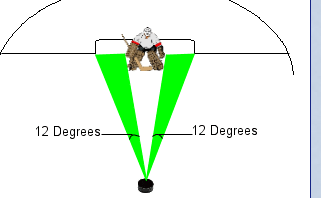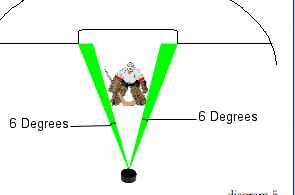Like scoring, goaltending is all about angles! The hockey net is 4 feet by 6 feet, and the goalie crease is a semi circle that is 8 feet long on the goal line, with a radius of 6 feet. In order to increase the chances of making a save, a goalie must decrease the players angle by being as far away from the goal line and towards the shooter, as possible. In order to do this, the goaltender must challenge the shooter and take away his time and space. Because the puck comes from the ground level, it rises as shot, which means the rate of elevation is important. By using the pictured triangle as an example, in addition to using the Pythagorean theorem, it is possible to figure out the total length from the puck to the target, as well as the angle of elevation. By finding these statistics, the reaction time of a goalie can be calculated, while also discovering how little time they have to stop the puck.



The pythagorean theorem states that a^2+b^2=c^2. By replacing the numbers in the photo to 4 feet for “a” (instead of 43) and 20 feet for “b” (instead of 192), the goal height and spot where the shot is coming from become very realistic in terms of normal hockey shot attempts: The hockey net is 4 feet high, and 20 feet out is a standard high quality scoring attempt. By using the Pythagorean theorem, a^2 + b^2= c^2. So 4^2 + 20^2= c^2 so 16+ 400= 416, then taking the square root of 416 gives the answer for “c” as 20.39. From here, you can use Sin-1 of b to figure out the angle the puck is elevated. Sin= opposite/hypotenuse which is 4/20.39=1.96, so sin-1(.196)= 11.3 which is the angle of elevation.
To calculate the reaction time the goalie must have in order to make the save, the formula “time= distance/rate” can be used. If the puck is shot from 20 feet out, at 85 mph, you must first convert mph to feet per seconds. 5280 feet= 1 mile. 3600 seconds= 1 hour, so 85 x 5280= 448,800 feet per hour. 448,800/3600= 124.66 feet per second. Then, 20 feet/ 124.66=.16 seconds. This means the goalie has .16 seconds to react to a shot from 20 feet away. This is an extremely small amount of time, but by being closer to the shooter and challenging him, the goalie can cut down the angle the puck has to go. In addition, how high the puck can be elevated by the time it hits him is reduced, which makes it easier for the puck to be saved!




